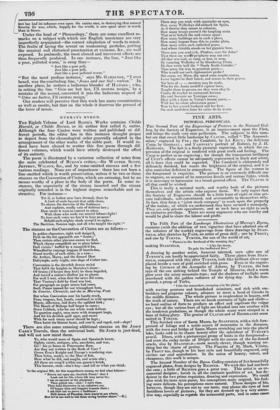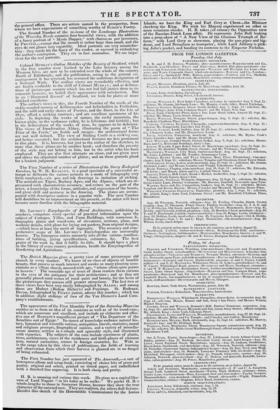The Fifth Part of the Landscape Illustrations of Murray's Byron,
contains (with the addition of two vignettes that have adorned one of the volumes of the world)) engravings from three drawings by STAN- FIELD, after sketches by PAGE, an artist of great skill ; one by Piton.; and one by TURNER. TURNER, the sun of the world of art, "Flames in the forehead of the morning sky," making STANFIELD, " Like the moon,
To pale his ineffectual fires."
A drawing by another artist, however talented, seen after one of TURNER'S, can hardly be appreciated fairly. These plates from STAN- FIELD, compared with this after TURNER, look like brilliant silver cups placed beside a vase of gold enriched with gems. Even in the engrav- ing by COUSINS of the Acropolis of Athens, by TURNER, the last rays of the sun sinking behind the Temple of Minerva, shed a warm glow over the misty mountain-tops ; and the shadows of twilight seem interfused with the golden radiance of the dying day. In the fore- ground, a group of Turks,
" Like the marauders, sweeping o'er the plain,"
with waving pennons and brandished scimitars, and rich with em- broidery and gorgeous colours, advance to meet a band of Greeks in the middle distance. The whole picture is resplendent in beauty, and the truth of nature. There are no harsh contrasts of light and shade— no hard outline of form to produce an effect and captivate the vulgar eye ; but all the various hues of light are blended into one another with the tenderest gradations„ as though the whole scene were steeped in a haze of fading glory. The genius of CLAUDE and of REMBRANDT seem united in TURNER. This finished view of Santa Maura, by STANFIELD, with a rich fore- ground of foliage and a noble screen of mountains in the distance, with the town and bridge of Santa Maura stretching out into the placid lake, looks cold in its chaste beauty after the splendour of TURNER'S pencil. Ithaca, with a picturesque group of boats in the foreground— and even the rocky ravine of Delphi with the cavern of the far-famed oracle, also by STANFIELD—SeeM merely clever, though wanting no- thing but the charm of genius. The Piazetta of St. Mark, Venice, by PROUT too, though in his best style and beautifully engraved, only excites our cool approbation. In the union of beauty, talent, and cheapness, this work is unique. The Second Number of the Byron Gallery consists of five beautifully engraved plates, from designs by RICHTER. We wish this had not been the case ; a little of RICHTER goes a great way. This artist is an or- namental designer; lavish in all the extrinsic qualities of art, but de- ficient in the two prime requisites, drawing and expression. We could also wish his taste were purer, his conceptions more original, his feel- ing more delicate, his perceptions more natural. These designs of his, however, though they are not to our taste; may please the eyes of less fastidious lovers of pictures ; for they are dressed up in a very attrac- tive way, especially as regards the accessorial parts, and in some cases
'the general effect. There are artists named in the prospectus, from whom we have expectations of something worthy of BYRON'S Poetry.
The Second Number of the re-issue of the Landscape Illustrations of the Waverley Novels contains four beautiful views, with the addition .of a fancy portrait of " Mysie Happer," with charms as per inventory, PRENTIS,-exeept that the mouth is rather large than small, and the eyes do not glance very roguishly. Ideal portraits are very unsatisfac- tory: they rarely hit the fancy of the reader, or succeed in embodying the author's conception. They are in fact anomalies. 'We are impa- tient for the real portraits.




























 Previous page
Previous page